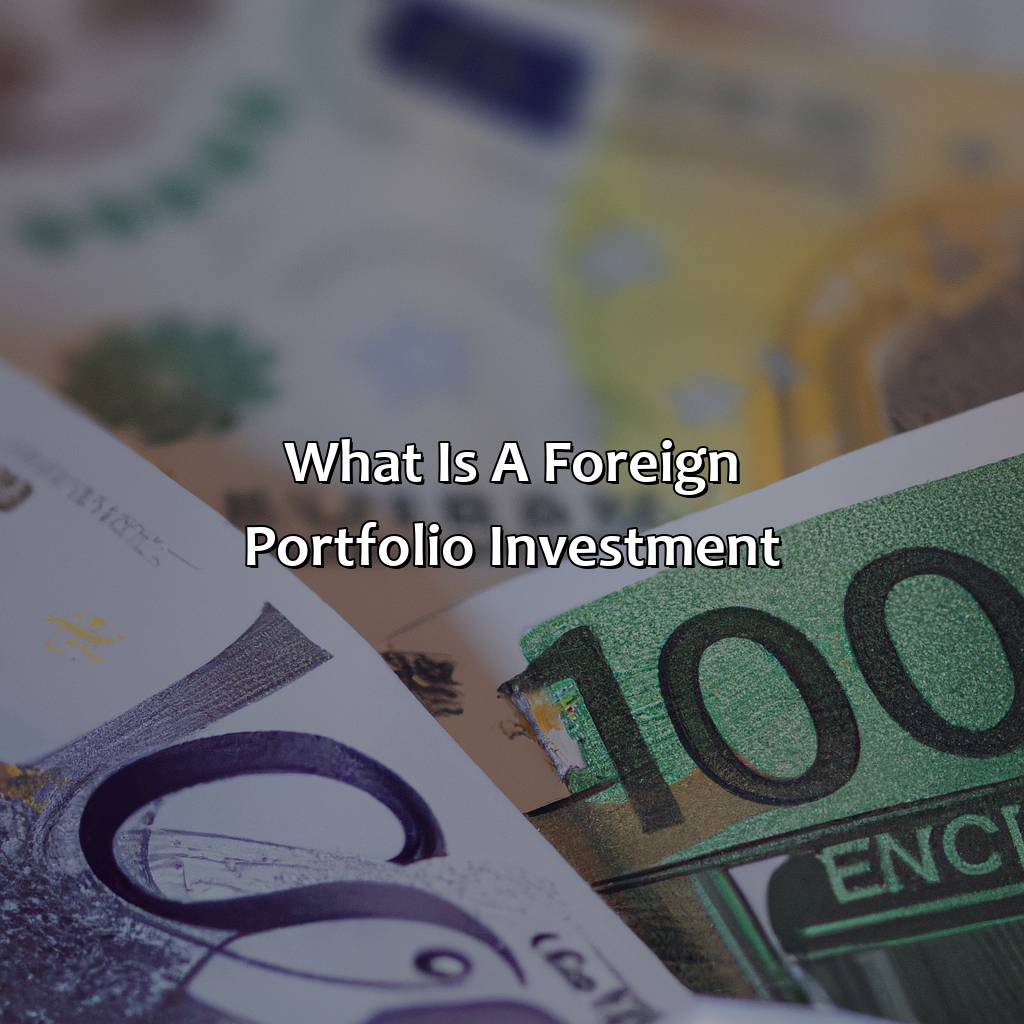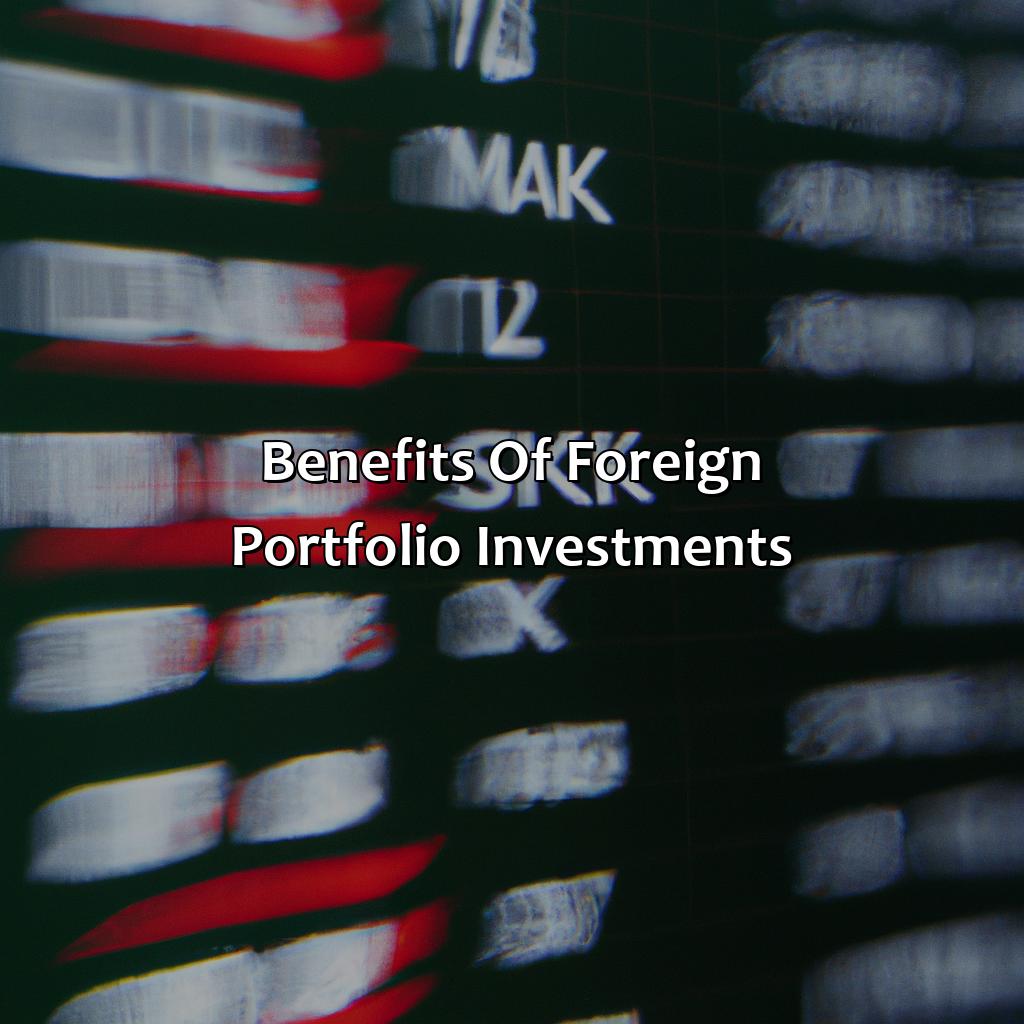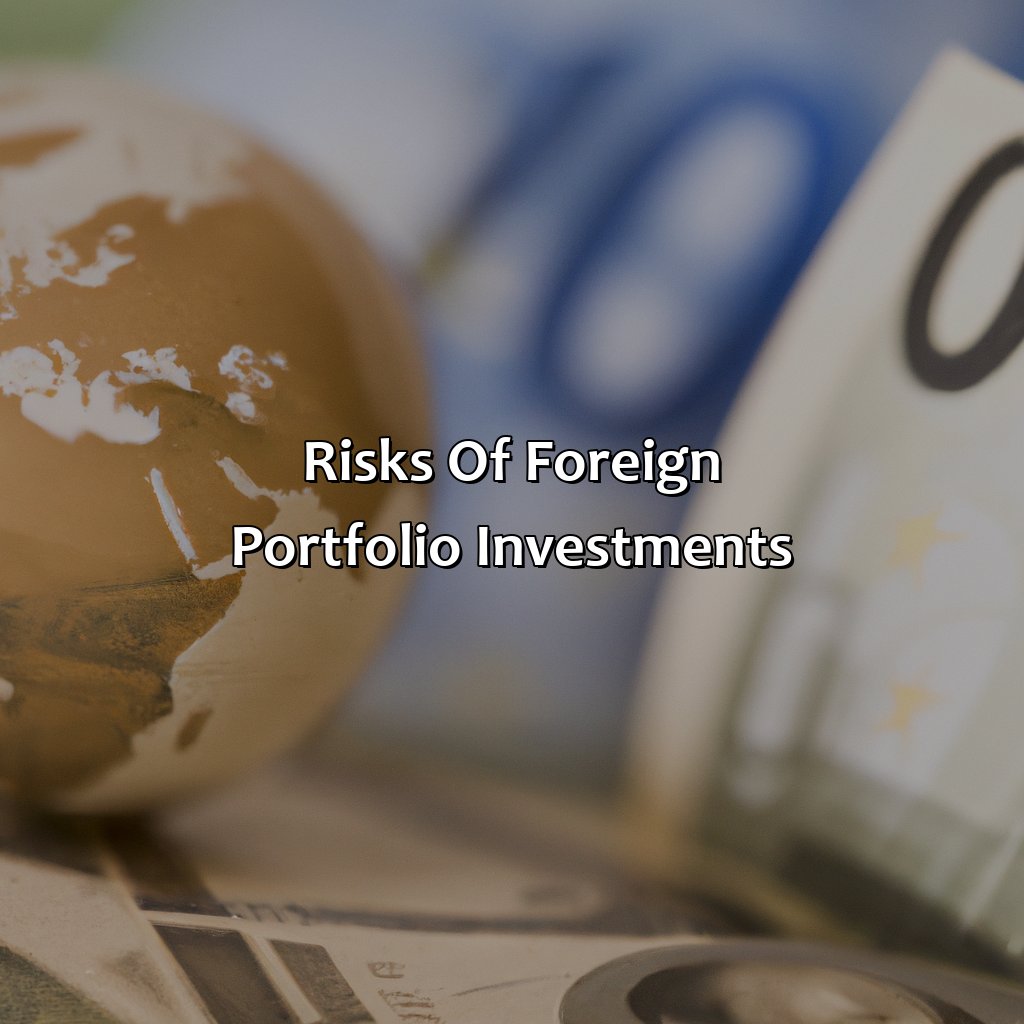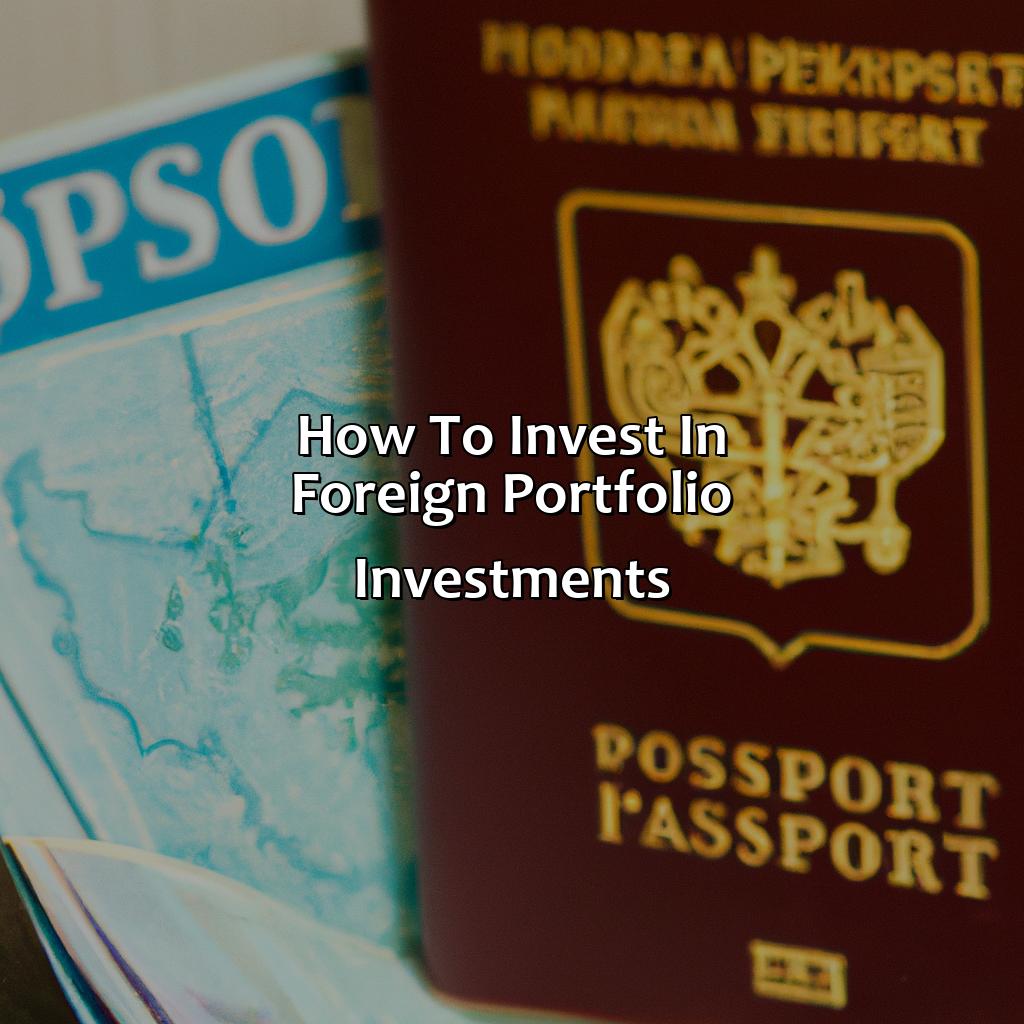What Is A Foreign Portfolio Investment?
Key Takeaways:
- Foreign Portfolio Investment (FPI) refers to investment made by foreign investors in the stock, debt, or other financial assets of a country other than their own.
- There are various types of FPI, including equity securities, debt securities, mutual funds, and exchange traded funds (ETFs), each with its own risks and potential returns.
- The benefits of FPI include diversification of risk, potential for high returns, and access to global markets, but there are also risks such as currency fluctuations, political and economic risks, and liquidity risks that investors should be aware of.
Are you curious about the basics of foreign portfolio investment? A foreign portfolio investment is a great way to diversify your portfolio and gain access to different markets. This article will cover the basics of FPI and explain the risks and rewards of investing in foreign markets.
What is a Foreign Portfolio Investment?
Foreign Portfolio Investment refers to investment made by individuals, funds, or institutions from one country in the financial securities of another country. This is a common practice among investors looking for diversification in their portfolios. It involves the purchase of securities such as stocks, bonds, and mutual funds issued by companies or governments in foreign countries.
Investors opt for Foreign Portfolio Investment to benefit from higher returns, diversify their portfolios, and gain exposure to foreign economies and currencies. This type of investment also enables investors to access new markets, industries, and technologies. The risks associated with Foreign Portfolio Investment include political, economic, and currency risks.
It is essential to conduct thorough research and analysis before investing in foreign securities to understand the economic and political conditions of the country, as well as the performance of the securities. Moreover, investors should diversify their investments across multiple countries and sectors to minimize the risks associated with this type of investment.
There have been instances where Foreign Portfolio Investment has caused financial crises. For example, the Asian financial crisis in 1997 was triggered by a massive outflow of Foreign Portfolio Investment from the region. Therefore, it is crucial to manage the flow of Foreign Portfolio Investment to ensure stability in the financial markets.

Image credits: retiregenz.com by James Arnold
Types of Foreign Portfolio Investments
To comprehend the multiple kinds of foreign portfolio investments, you must be aware of the various investment securities. In this section on Types of Foreign Portfolio Investments, we will delve into Equity Securities, Debt Securities, Mutual Funds, and Exchange Traded Funds (ETFs). We will discover each investment’s unique traits and advantages.

Image credits: retiregenz.com by Adam Woodhock
Equity Securities
Equity investments belong to the category of ownership securities that offer investors partial ownership of a company. These investments provide shareholders with the right to vote at shareholder meetings and receive dividends based on the company’s profits.
Investors who engage in equity securities must be aware of the volatile nature of these investments, as they are prone to fluctuations based on factors like market conditions, economic indicators, and company news. The main types of equity securities are common stocks and preferred stocks, each with unique characteristics.
Common stocks represent ownership in a company and carry voting rights, but no guarantee of dividend payments. Preferred stocks generally have a fixed dividend rate and take priority over common stockholders for payment in the event of liquidation.
Investors can benefit from diversifying their portfolios by investing in a range of equities across industries and geographic locations. Moreover, it is essential to analyze financial reports, understand long-term goals and management strategies for each investment before making decisions.
Ultimately, equity securities offer an opportunity for significant gains but require careful research and analysis before making any buy or sell decisions. Investors must be prepared for potential risks and understand that there are no guarantees in this type of investment.
Taking a chance on foreign debt securities is like playing Russian roulette, except you have no idea how many bullets are in the chamber.
Debt Securities
Investing in financial instruments that depict a creditor-debtor relationship with the issuer of the security comes under the category of debt securities.
These types of securities include government bonds, corporate bonds, debentures, and treasury bills. Debt securities are classified based on their duration, credit rating, coupon rate, and currency. Investing in debt securities provides a fixed income to investors in the form of interest payments and is considered a safer investment option than equity securities.
Debt securities provide an opportunity for investors to diversify their portfolios and reduce risk by investing in multiple fixed-income assets. Moreover, these securities have a lower volatility risk as compared to equity investments.
Investors who do not invest in debt securities miss out on a stable source of income. Hence, it is recommended for them to diversify their portfolios by including a variety of assets such as debt securities.
Mutual funds: Because giving your money to strangers to invest in strangers’ companies is always a solid financial plan.
Mutual Funds
Investing in a non-domestic financial investment that is funded by multiple investors, with the aim of earning returns is referred to as a Cooperative Investment. This type of investment can be managed actively or passively.
In Mutual funds, the managers invest in various assets as per the investors’ interests and needs. The invested money is combined into one account and invested in stocks, fixed-income securities or a combination of both.
The managed pool of investments permits risk management by diversification which helps in minimizing the potential losses. It offers the advantage of entry into diverse markets to those who might not have had access to it otherwise. Mutual funds offer relative ease and provide fair levels of liquidity as well, permitting quick buying and selling of shares.
Pro Tip: Understanding past performance trends and mutual fund ratings can help make more informed decisions when investing in mutual funds.
ETFs: Where investing in a diversified basket of stocks is just a fancy way of saying ‘I can’t pick winners, so let’s hope for the best’.
Exchange Traded Funds (ETFs)
One of the options for foreign portfolio investments is investments in Tradable Baskets. This type of investment, commonly referred to as Exchange Traded Funds (ETFs), allows investors to invest in a collection of different assets, such as stocks or bonds, all at once. ETFs are traded on stock exchanges similarly to individual stocks.
As a result of their nature and structure, ETFs offer several benefits for investors seeking exposure to a particular market sector or asset class. For example, they provide the benefit of diversification as they offer multiple holdings with one investment rather than holding each stock separately. Additionally, exchange-traded funds generally have lower management fees than traditional mutual funds.
Unlike mutual funds that are priced only once daily at the end of the trading day, ETFs prices fluctuate during trading hours because they are traded like individual stocks.
Investors may find that ETF’s possess liquidity with high trading volume and minimal bid-ask spreads on major exchanges such as NASDAQ and NYSE.
For instance, considering an investor looking to obtain instant access to a diversified portfolio instead of buying individual securities can choose this option. By purchasing Exchange Traded Funds that owns several companies spread across various industries and locations globally can increase the investor’s risk tolerance while earning returns over time without having the knowledge and expertise with individual security analysis.
Brace yourselves for the benefits of foreign portfolio investments:
- higher returns
- diversified portfolio
- and a newfound love for international markets.
Benefits of Foreign Portfolio Investments
Gain benefits by investing in foreign portfolios!
This section provides insight into the sub-sections. Diversifying risk, potential for high returns, and access to global markets are key to any investor. Before investing, understand these benefits!

Image credits: retiregenz.com by David Jones
Diversification of Risk
Investing in foreign portfolio investments reduces the concentration of risk by diversifying across various asset classes, geographic regions and sectors. By allocating funds across various portfolios, one can minimize potential losses that may arise from market volatility in a specific investment. This diversification creates a more balanced portfolio with lower risk as compared to a single concentrated investment.
Moreover, the risks associated with political instability and economic turmoil in a particular country can be mitigated if the portfolio is diversified globally. A well-diversified portfolio also ensures long-term financial stability while multiplying the profits. Furthermore, it allows investors to benefit from different currencies, interest rates, inflation and economic cycles across countries.
A common pro tip for Investors is to balance their portfolios by investing in several types of assets from several countries or regions worldwide. This improves their chances of achieving long-term financial stability while minimizing their overall risk level.
If you’re looking for a high-return investment, forget the lottery and try foreign portfolio investments – just make sure you have a good internet connection for checking those stock prices!
Potential for High Returns
The possibility of achieving favorable returns makes foreign portfolio investments an attractive option for investors looking to diversify their portfolio. The potential for high returns in foreign markets arises due to a variety of factors, including favorable economic conditions, undervalued currencies, and emerging industries. High-performing investments in multiple foreign markets can boost the overall profitability of a diversified portfolio.
To maximize the potential for high returns, investors need to conduct thorough research on market trends and economic indicators, particularly those that could affect the performance of their investment. Additionally, investing in well-established financial institutions with a proven track record of success can reduce the risks associated with investing in unfamiliar markets.
Finally, it’s essential to have realistic expectations when investing in foreign markets. While the potential for high returns is significant, there are also inherent risks involved that could result in losses if not managed correctly. As such, investors should work with experienced financial advisors to develop a strategy that aligns with their risk tolerance level.
Pro Tip: Keep a close eye on market trends and regularly review your portfolio’s performance to ensure your investments remain aligned with your goals and risk tolerance level.
Who needs a passport when you have a foreign portfolio investment to give you access to global markets?
Access to Global Markets
Expanding the horizons of investment possibilities, foreign portfolio investments offer investors access to international markets. Diversifying investments through a variety of instruments such as stocks, bonds, and mutual funds, global markets offer extensive investment opportunities with varying degrees of risk and reward. Through such investments, investors can take advantage of fluctuations in exchange rates and gain exposure to emerging markets, potentially increasing returns in their portfolio.
Foreign portfolio investments open up new avenues for investors that may not be available locally. For example, foreign stock markets may have companies that are leaders in an industry or offer products and services not typically available in the investor’s home country. Likewise, foreign bond markets may provide high yields or special tax exemptions that can further diversify an investor’s holdings.
Additionally, accessing global markets through foreign portfolio investments allows investors to hedge against currency risk with an increased ability to move money between countries. Increased diversification also lowers the investor’s risk profile across different investment classes offered across international borders.
It is believed that portfolio investments were first utilized by Isaac Le Maire during the Dutch East India Company era when he used derivatives to short sell company stocks then artificially lowered prices through rumors. He ultimately faced legal action but this event demonstrates how early use of foreign portfolio investing was centered around taking advantage of market inefficiencies.
Brace yourselves for the rollercoaster ride of foreign portfolio investments – it’s like going on a blind date with your money.
Risks of Foreign Portfolio Investments
To limit the dangers associated with foreign portfolio investments, it’s essential to take into account the subsections in the ‘Risks of Foreign Portfolio Investments’ section. These are: Currency Fluctuations, Political and Economic Risks, and Liquidity Risks.

Image credits: retiregenz.com by Joel Arnold
Currency Fluctuations
The risks of investing in foreign portfolios are manifold, and the fluctuations in currency valuation are one of them. The value of a currency changes frequently due to various macroeconomic factors such as inflation, geopolitical tensions, trade agreements, or central bank policies. These frequent alterations can have an impact on the portfolio’s value as investments made in other currencies incur conversion costs.
For example, let’s say an investor based in the United States buys stocks in Japan valued at ¥1 million when the exchange rate is $1 = ¥100. However, after some time has passed, if the yen appreciates to $1 = ¥90, then the original investment that was worth $10,000 would now only be worth roughly $11,111 instead of its previous amount.
Many policy decisions influencing currency fluctuations cannot be predicted considering how unpredictable global structures can be. This makes it very difficult to manage potential losses from shifts that occur within short periods for investors holding foreign portfolio investments.
Looks like investing overseas comes with a side of political drama and economic rollercoasters. Fasten your seatbelts, folks.
Political and Economic Risks
Foreign portfolio investments can expose investors to a range of inherent risks, including political and economic uncertainties. A country’s changing political environment or deteriorating economic conditions can have a significant impact on the performance of an investor’s portfolio.
Political factors such as government instability, policy changes, and national security concerns may lead to market volatility and affect the value of investments in that country. Similarly, economic risks such as inflation, currency fluctuations, and interest rate variations can impact investment returns.
It is essential for investors to evaluate carefully the potential risks associated with foreign portfolio investments before committing funds to such ventures. The selection of appropriate investment options and diversification across various markets can help minimize risk exposure.
Furthermore, external factors beyond an investor’s control such as natural disasters or pandemics can also impact foreign portfolios. Therefore, risk management strategies should be employed to mitigate overall risk levels and safeguard investments.
In a related case, during the global financial meltdown in 2008-09, emerging markets were significantly affected by the withdrawal of foreign portfolio investments which led to a significant drop in stock prices within these countries. Thus highlighting that Political and Economic Risks are critical considerations when making foreign portfolio investments.
Foreign portfolio investments: where your money goes to travel the world, but may end up getting stuck in a no man’s land of liquidity risks.
Liquidity Risks
Investments in foreign portfolios come with a lot of uncertainties, and the aspect of liquidity risks is one of them. This risk poses a threat to investors because it is difficult to sell an asset quickly without incurring too much loss.
In most cases, investors have to wait for quite some time to get the right buyer who is willing to purchase the asset at a good price. The challenge worsens when the market conditions are unfavorable, making it impossible to locate potential buyers. In such scenarios, investors may be forced to sell at a lower price than they purchased it.
Foreign portfolio liquidity risks can be mitigated by diversifying investments across several markets. By investing in multiple countries and not just one, you can lower your overall investment risk exposure while also ensuring that you can redistribute your assets efficiently should you face difficulties selling them in one market.
Investors can further mitigate this risk by conducting thorough research on which markets are likely to provide more liquidity in adverse situations. Conducting due diligence before investing means selecting markets that not only provide higher liquidity levels but also ones that exhibit relatively stable economic indicators concerning potential growth opportunities.
Get ready for some global diversification with these tips on investing in foreign portfolio investments.
How to Invest in Foreign Portfolio Investments
Strategize to steer clear of undesired results when investing in foreign portfolio investments. Take advantage of a financial advisor for informed decisions. Research the different investment options. Always factor in your investment goals and risk tolerance. This will guarantee success for your portfolio investments.

Image credits: retiregenz.com by Harry Jones
Consult a Financial Advisor
Acquire professional assistance from a financial expert to gain valuable insights and make informed decisions regarding foreign portfolio investments. A competent advisor can help you navigate the complexities of international markets and identify profitable investment opportunities.
An experienced financial advisor possesses subject matter expertise, market knowledge, and analytical skills necessary to deliver valuable advice on a diverse range of investment strategies like diversification, asset allocation, and risk management. They can also provide comprehensive guidance on tax implications, fees, documentation requirements and help create an investment plan that caters to your specific goals.
To find a good financial advisor, conduct thorough research, check their credentials, certifications, client testimonials and evaluate if they align with your needs. It is also vital to have open communication with your advisor to establish trust-based relationships.
In addition to seeking professional guidance from a financial expert, educate yourself on the fundamentals of foreign portfolio investments by reading reliable sources such as the World Bank and International Monetary Fund reports. Doing so will enable you to develop a holistic understanding and make well-informed decisions.
If all else fails, just throw a dart at a map and invest in whatever country it lands on.
Research Different Investment Options
To explore various investment opportunities, one must delve into the realm of financial options. This endeavor entails traversing different strategies to suit individual preferences and goals. With that said, there are several directions one can take when investigating investment choices.
- Study the types of available funds on the market.
- Research the structures and fees for each investment option.
- Compare and contrast the potential gains and risks of each opportunity.
- Analyze current trends in both national and global markets.
- Explore taxation regulations that may affect foreign investments.
- Consult with trusted financial advisors qualified to provide tailored advice regarding portfolio diversification.
Examining various sources will prove beneficial. Perhaps researching economic reports or journal articles may shine a light on suitable investments. Although, always remain alert and critique sources productively.
This year alone, emerging markets have gained much attention from investors throughout the globe. According to Bloomberg Markets: “investors have poured $2 billion into developing-nation bond funds in one week,” demonstrating a trend towards investing in international portfolios.
Consider Your Investment Goals and Risk Tolerance
When devising investment strategies, it’s crucial to evaluate individual financial goals and risk tolerance. To maximize returns, one must carefully consider their willingness to take risks. Assessing such factors enables foreign portfolio investments that correspond with specific investing objectives.
Investment goals and risk tolerance are interdependent variables, as low-risk tolerances provide lower return opportunities and high-risk targets yields more earnings at greater risk. With a better understanding of your financial goals and the degree of risk you’re comfortable taking on, selecting an optimal global portfolio investment becomes attainable.
The aim is to develop an investing strategy that delivers optimal results for your personal situation. By analyzing a diversity of investment funds spanning several markets worldwide, one can determine whether or not the potential gains warrant accepting the associated risks.
Looking beyond standard stock options is key to get ahead of competitors in this field. Investing in non-traditional assets can open new investment opportunities in emerging market sectors left untapped by others.
A recent example which highlights the importance of following this process correctly was seen when institutions overinvested in real estate holdings before the 2008 financial crisis. Understanding risks limits and how they interact with your objectives can help avoid significant losses during times of volatility in the market.
Some Facts About Foreign Portfolio Investment:
- ✅ Foreign Portfolio Investment (FPI) is an investment made by foreigners in the stock markets of another country. (Source: The Economic Times)
- ✅ FPI is a subset of Foreign Direct Investment (FDI) and is more liquid and less controlling. (Source: Investopedia)
- ✅ FPI allows for portfolio diversification and access to international markets. (Source: E-International Relations)
- ✅ Government policies and economic conditions of a country affect the inflow of FPI. (Source: The Financial Express)
- ✅ Major investors in FPI include institutional investors like pension funds, hedge funds, and exchange-traded funds (ETFs). (Source: The Balance)
FAQs about What Is A Foreign Portfolio Investment?
What is a foreign portfolio investment?
A foreign portfolio investment refers to an investment made by an individual or firm in stocks, bonds, or other financial assets from a foreign country. This type of investment allows investors to diversify their portfolio and potentially earn higher returns.
What are the benefits of a foreign portfolio investment?
Foreign portfolio investments offer several benefits, including: a diversified investment portfolio, potential for higher returns, exposure to new markets, reduced risk through hedging, and the opportunity to invest in companies with strong growth potential.
What are the risks associated with a foreign portfolio investment?
There are several risks associated with foreign portfolio investments, including: currency risk, political instability, economic instability, and regulatory changes. These risks can potentially result in financial losses for investors.
What are some examples of foreign portfolio investments?
Examples of foreign portfolio investments include: buying shares of a foreign company listed on a stock exchange, purchasing bonds issued by a foreign government, or investing in a mutual fund or exchange-traded fund (ETF) that provides exposure to foreign assets.
How can I invest in foreign portfolios?
Individual investors can invest in foreign portfolios through brokerage firms or online investment platforms that offer access to international markets. Institutional investors, such as pension funds and hedge funds, can invest in foreign portfolios through specialized investment managers.
What are the tax implications of a foreign portfolio investment?
The tax implications of a foreign portfolio investment depend on the investor’s home country and the country in which the investment is made. Investors may be subject to taxes on capital gains, dividends, and interest income, and may need to file tax returns in both countries.
